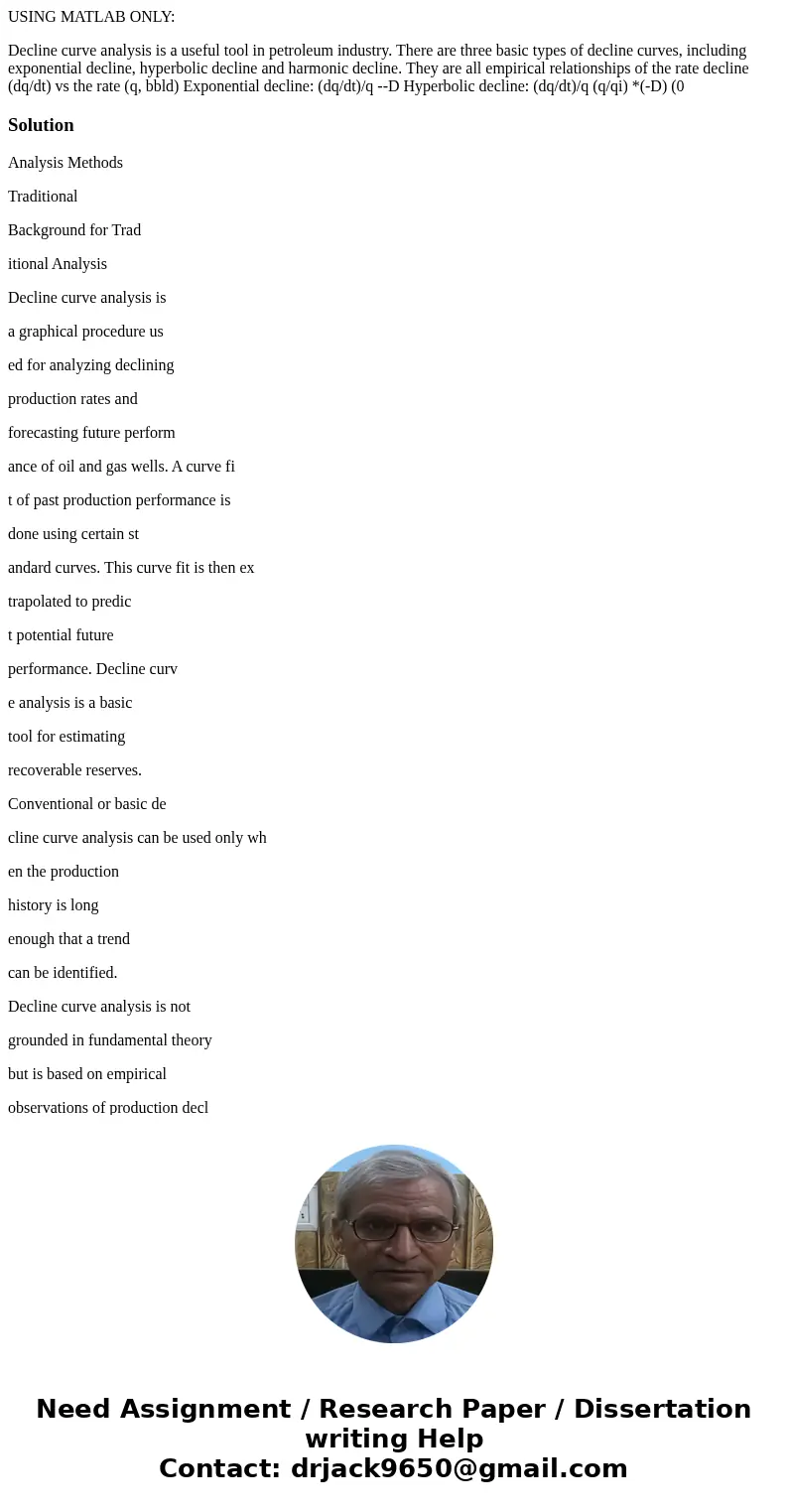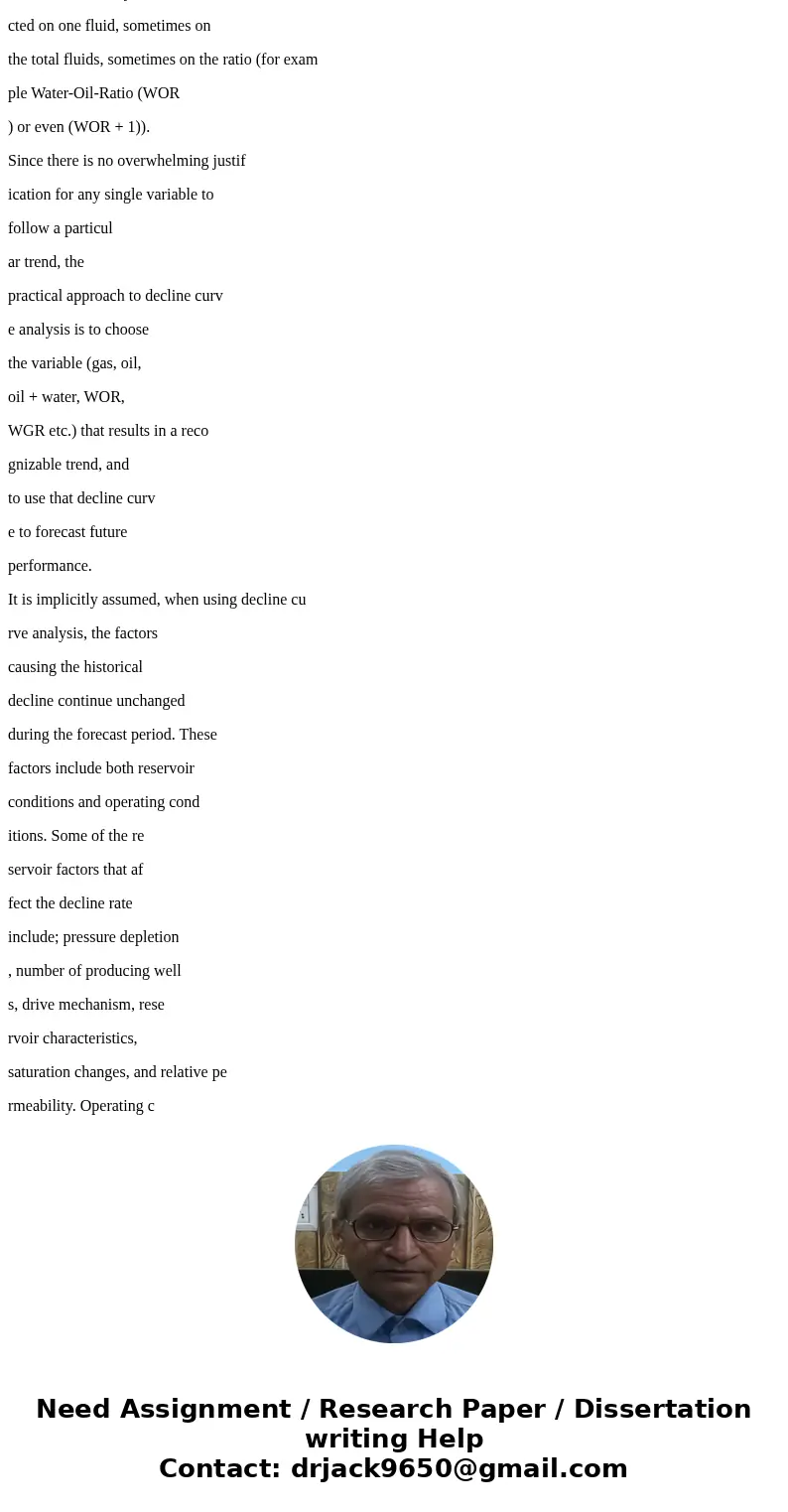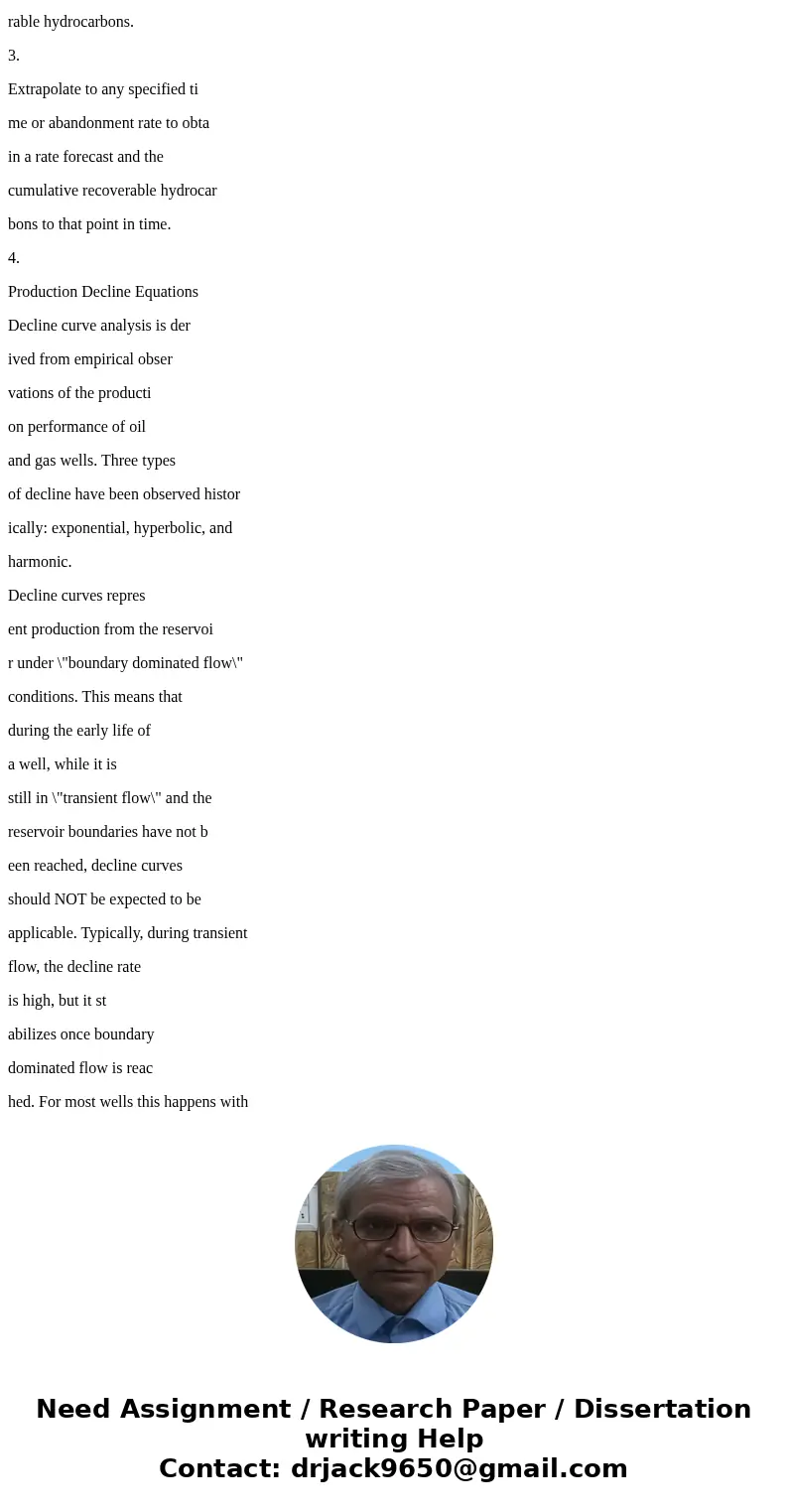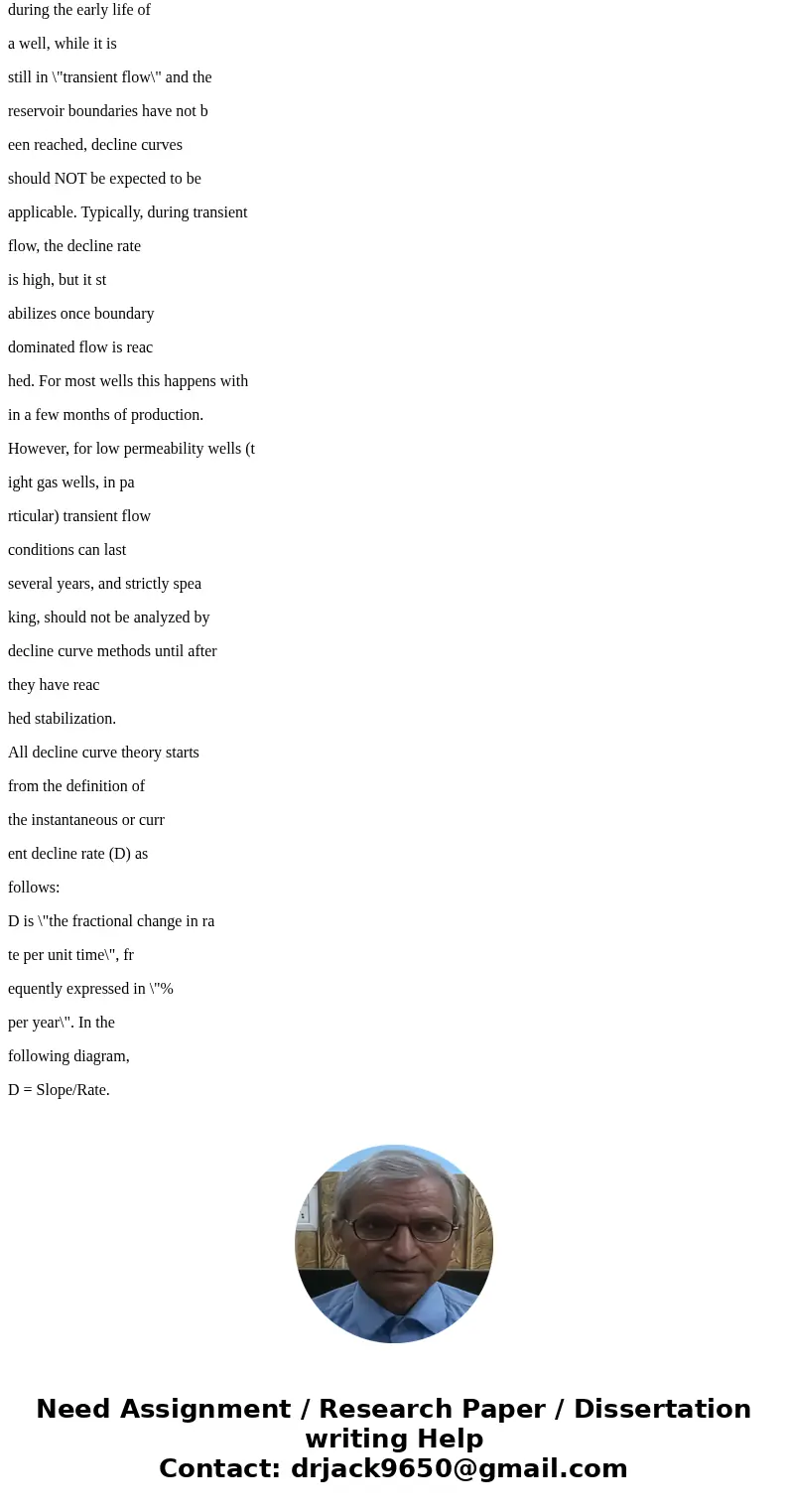USING MATLAB ONLY Decline curve analysis is a useful tool in
USING MATLAB ONLY:
Decline curve analysis is a useful tool in petroleum industry. There are three basic types of decline curves, including exponential decline, hyperbolic decline and harmonic decline. They are all empirical relationships of the rate decline (dq/dt) vs the rate (q, bbld) Exponential decline: (dq/dt)/q --D Hyperbolic decline: (dq/dt)/q (q/qi) *(-D) (0Solution
Analysis Methods
Traditional
Background for Trad
itional Analysis
Decline curve analysis is
a graphical procedure us
ed for analyzing declining
production rates and
forecasting future perform
ance of oil and gas wells. A curve fi
t of past production performance is
done using certain st
andard curves. This curve fit is then ex
trapolated to predic
t potential future
performance. Decline curv
e analysis is a basic
tool for estimating
recoverable reserves.
Conventional or basic de
cline curve analysis can be used only wh
en the production
history is long
enough that a trend
can be identified.
Decline curve analysis is not
grounded in fundamental theory
but is based on empirical
observations of production decl
ine. Three types of decline
curves have been identified;
exponential, hyperbolic, and
harmonic. There are th
eoretical equivalents to these decline curves
(for example, it can be demons
trated that under cert
ain circumstances, such
as constant well
backpressure, equations of fl
uid flow through porous media
under \"boundary-dominated flow\"
conditions are equiva
lent to \"exponential\"
decline). However, decli
ne curve analysis is
fundamentally an empi
rical process based on hist
orical observations of we
ll performance. Because
of its empirical nature,
decline curve analysis is applied, as
deemed appropriate for any particular
situation, on single or multi-fluid
streams. For example,
in certain instances, t
he oil rate may exhibit
an exponential decline, while
in other situations it is
the total liquids (oil +
water) that exhibit the
exponential trend. Thus, in some
instances, the analysis is condu
cted on one fluid, sometimes on
the total fluids, sometimes on the ratio (for exam
ple Water-Oil-Ratio (WOR
) or even (WOR + 1)).
Since there is no overwhelming justif
ication for any single variable to
follow a particul
ar trend, the
practical approach to decline curv
e analysis is to choose
the variable (gas, oil,
oil + water, WOR,
WGR etc.) that results in a reco
gnizable trend, and
to use that decline curv
e to forecast future
performance.
It is implicitly assumed, when using decline cu
rve analysis, the factors
causing the historical
decline continue unchanged
during the forecast period. These
factors include both reservoir
conditions and operating cond
itions. Some of the re
servoir factors that af
fect the decline rate
include; pressure depletion
, number of producing well
s, drive mechanism, rese
rvoir characteristics,
saturation changes, and relative pe
rmeability. Operating c
onditions that influence the decline rate
are: separator pressure,
tubing size, choke
setting, workovers, compre
ssion, operating hours, and
artificial lift. As long
as these conditions do not
change, the trend in dec
line can be analyzed and
extrapolated to foreca
st future well performance. If thes
e conditions are altered, for example
through a well workover, then the
decline rate determi
ned pre-workover will
not be applicable to
the post-workover period.
When analyzing rate decline,
two sets of curves are
normally used. The flow ra
te is plotted against
either time or cumulati
ve production. Time is the most c
onvenient independent
variable because
extrapolation of rate-time graphs
can be directly used for pr
oduction forecasting and economic
evaluations. However, plots of
rate vs. cumulative production
have their own advantages; Not only
do they provide a di
rect estimate of the
ultimate recovery at
a specified economic
limit, but
will also
yield a more rigorous interpretation
in situations where t
he production is influe
nced by intermittent
operations.
Good engineering practice demands
that, whenever possible, decli
ne curve analysis should be
reconciled with other indicators of
reserves, such as volumetric ca
lculations, material balance, and
recovery factors. It should be
noted that decline cu
rve analysis results in
an estimate of
Recoverable Hydrocarbons, and NO
T in Hydrocarbons-in-Place.
Whereas the Hydrocarbons-in-
Place are fixed by nature, the Re
coverable hydrocarbons
are affected by the
operating conditions.
For example a well producing from
a reservoir containing 1BCF of
gas-in-place may
recover either
0.7 BCF or 0.9 BCF, depending on
whether or not ther
e is a compressor connected at the
wellhead.
The following steps are taken for
exponential decline anal
ysis, and for predicting
future flow rates
and recoverable reserves:
Plot flow rate vs. time on a
semi-log plot (y-axis is logarithm
ic) and flow rate
vs. cumulative
production on a Cartesian (ari
thmetic coordinate) scale.
1.
Allowing for the fact that the ear
ly time data may not be
linear, fit a strai
ght line through the
linear portion of the data
, and determine the decline ra
te \"D\" from the slope (-
D
/2.303) of the
semi-log plot, or
directly from the slop
e (D) of the rate-cumul
ative production plot.
2.
Extrapolate to
q
=
q
E
to obtain the recove
rable hydrocarbons.
3.
Extrapolate to any specified ti
me or abandonment rate to obta
in a rate forecast and the
cumulative recoverable hydrocar
bons to that point in time.
4.
Production Decline Equations
Decline curve analysis is der
ived from empirical obser
vations of the producti
on performance of oil
and gas wells. Three types
of decline have been observed histor
ically: exponential, hyperbolic, and
harmonic.
Decline curves repres
ent production from the reservoi
r under \"boundary dominated flow\"
conditions. This means that
during the early life of
a well, while it is
still in \"transient flow\" and the
reservoir boundaries have not b
een reached, decline curves
should NOT be expected to be
applicable. Typically, during transient
flow, the decline rate
is high, but it st
abilizes once boundary
dominated flow is reac
hed. For most wells this happens with
in a few months of production.
However, for low permeability wells (t
ight gas wells, in pa
rticular) transient flow
conditions can last
several years, and strictly spea
king, should not be analyzed by
decline curve methods until after
they have reac
hed stabilization.
All decline curve theory starts
from the definition of
the instantaneous or curr
ent decline rate (D) as
follows:
D is \"the fractional change in ra
te per unit time\", fr
equently expressed in \"%
per year\". In the
following diagram,
D = Slope/Rate.








 Homework Sourse
Homework Sourse